Food and nutrition topics likely to impact the Dairy Community in the next 1 to 3 years.
By: Kristal Shelden, MPH, RDN and Ashley Rosales, RDN
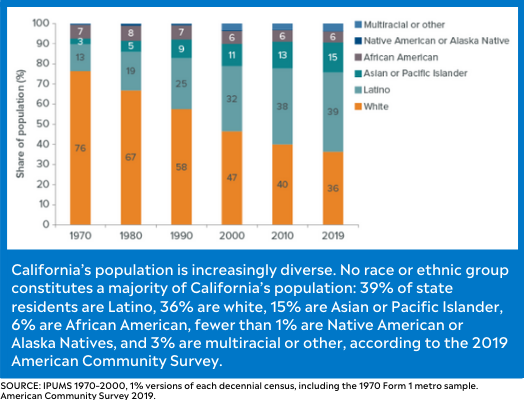 Against the backdrop of an ongoing pandemic, climate change and rising rates of food insecurity and obesity, the United States has seen shifts in its demographics with an unprecedented growth in minority populations, smaller households and more
people living in urban settings. According to 2020 U.S. census data, more than half of U.S. children are from a racial/ethnic minority group, with Latino and Black children comprising nearly 40% of the U.S. child population. The characteristics of
a traditional household are also shifting, with more couples living with no children and more people living alone. Overall, the average household size is 2.6.1 Combined, these changes
are reshaping the food environment, policies and education.
Against the backdrop of an ongoing pandemic, climate change and rising rates of food insecurity and obesity, the United States has seen shifts in its demographics with an unprecedented growth in minority populations, smaller households and more
people living in urban settings. According to 2020 U.S. census data, more than half of U.S. children are from a racial/ethnic minority group, with Latino and Black children comprising nearly 40% of the U.S. child population. The characteristics of
a traditional household are also shifting, with more couples living with no children and more people living alone. Overall, the average household size is 2.6.1 Combined, these changes
are reshaping the food environment, policies and education.
People are continuing to center their lives around the home and placing emphasis on balancing physical and mental health. Consumers are shopping with their values in mind, feeling deeply connected to food and understanding the links to health, but with less recognition of the impact on natural resources and environment.2 At the same time, the use of technology continues to change the face of health care, schools and the work place.
Ongoing shifts to the U.S. population make it more important than ever to meet the needs of individuals and to understand individual perspectives. The challenges and complexities of an ever-changing world present opportunities for innovation and collaboration at all levels. It is through this lens that Dairy Council of California presents the trends for the dairy community.

Generation Z is coming of age and becoming a dominating force. This demographic group includes persons born from the mid-1990s to around 2010, and it is now the largest and most ethnically diverse demographic group in the United States.1 Many previous generations have been advocates for social change as they came into adulthood, but Gen Zers have their own characteristics born from issues unique to their time—such as climate crises, technology and a world that’s more connected than ever before. They are positioning themselves not only as consumers but also as mobilizers. Purchasing decisions are based on values, with more interest in sustainability. They want to know where their food comes from and what impacts their choices will make. As a result, food companies are taking positions on issues from climate change to social justice, with broader implications that could shape policy.
 Gen Z is also bringing everyone into the digital world. Video content on social media platforms such as TikTok dominates communication channels and marketing. Online games are being used to educate students in schools. Digital health care has become
mainstream as many health issues are now treated through telehealth appointments. While the pandemic played a large role in accelerating the expansion of the digital space, Gen Z will continue to lead the way into a digitally connected future.
Gen Z is also bringing everyone into the digital world. Video content on social media platforms such as TikTok dominates communication channels and marketing. Online games are being used to educate students in schools. Digital health care has become
mainstream as many health issues are now treated through telehealth appointments. While the pandemic played a large role in accelerating the expansion of the digital space, Gen Z will continue to lead the way into a digitally connected future.
Partners in the dairy industry are shifting to align to and serve this demographic by developing games and addressing value-based purchasing decisions. Marketing strategies that target Gen Zers are incorporating value-based terms that appeal to lifestyle, such as “calm,” “restore” and “energize.”3 Using games for education has also become a way to attract Gen Zers. Several new online gaming activities targeting Gen Z were released by dairy industry partners to teach about dairy nutrition, farming and dairy’s sustainability story. For example, a partnership between Fuel Up to Play 60 and GoNoodle launched a collection of online games that lets players directly challenge friends or family in competition, including activities that involve collecting milk, yogurt, and string cheese for points.4
Implications: As the oldest of Gen Z are entering early adulthood and may soon form families of their own, their knowledge and values will begin to influence a new generation. Connecting with the Gen Z age group will require engaging in unique and meaningful ways, such as exploring new digital communication options, recognizing socio-economic or cultural perspectives, or aligning to values that are important. Dairy Council of CA continues to innovate and collaborate with partners to advance nutrition education, ensuring dairy foods remain a valued part of healthy eating patterns for present and future generations.

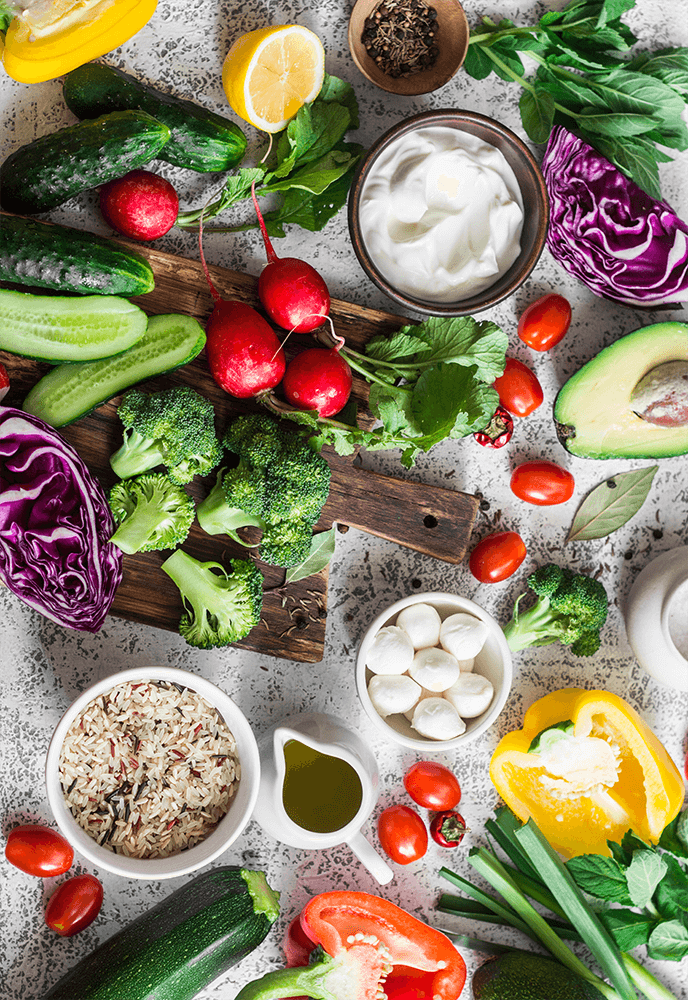 Plant-based foods positioned as solution to climate crisis
Plant-based foods positioned as solution to climate crisisClimate change has been elevated to the “biggest threat modern humans have ever faced,” with a call to action to achieve a sustainable food system.5 Advocates for plant-based eating are seizing on the opportunity to position their movement as a solution. The value of plant-based foods and products is rapidly increasing, not only driven by perceived health benefits but also by perceived climate impact. The plant-based food market, which includes processed alternatives to animal source foods, has experienced significant growth over the last few years,6 and mobilization by Gen Z and urgency to address climate change is creating a new platform. Sustainability is a strategic focus of many plant-based alternative food companies, which are especially targeting youth who have a growing voice in advocacy. Strategies include publishing online guides to help teens talk to their parents about meat’s impact on climate change and gaining USDA approval to serve their products in school cafeterias.
The plant-based movement is also expanding into schools through nutrition education and ag literacy. The Farm to School program in California has gained unprecedented support and funding since the movement first began, with Governor Newsom committing $60 million over the next two years to expand the California Farm to School Incubator Grant Program.7 The USDA’s Farm to School grant program also gave out a record $12 million in grants 8 with 22 sites in California receiving a portion of this funding.9 The focus of these programs has primarily been on expanding healthy food access in schools while supporting farmers and food literacy education, including school gardens. Over the past five years, more organizations with a plant-based focus have developed educational programs for schools. One example is Foodprints, which are lessons used to teach children about food choices and their connection with the environment, animal welfare and food justice.10
Implications: The plant-based movement as a solution to climate change provides an overly simplistic view of a complex problem. Moving toward a healthy and sustainable food system will require a holistic approach, inclusive of plant and animal source foods that provide different though complementary nutritional, social, economic and environmental benefits. There is opportunity for the dairy community to shape the conversation to ensure sustainable nutrition remains inclusive of animal source foods, like dairy. Nutrition research continues to demonstrate the benefits of dairy foods as an affordable and sustainable way to address the nutritional needs of a growing population. Dairy Council of CA prioritizes providing nutrition education and ag literacy in schools to ensure dairy foods are valued as important components of healthy, sustainable food systems.

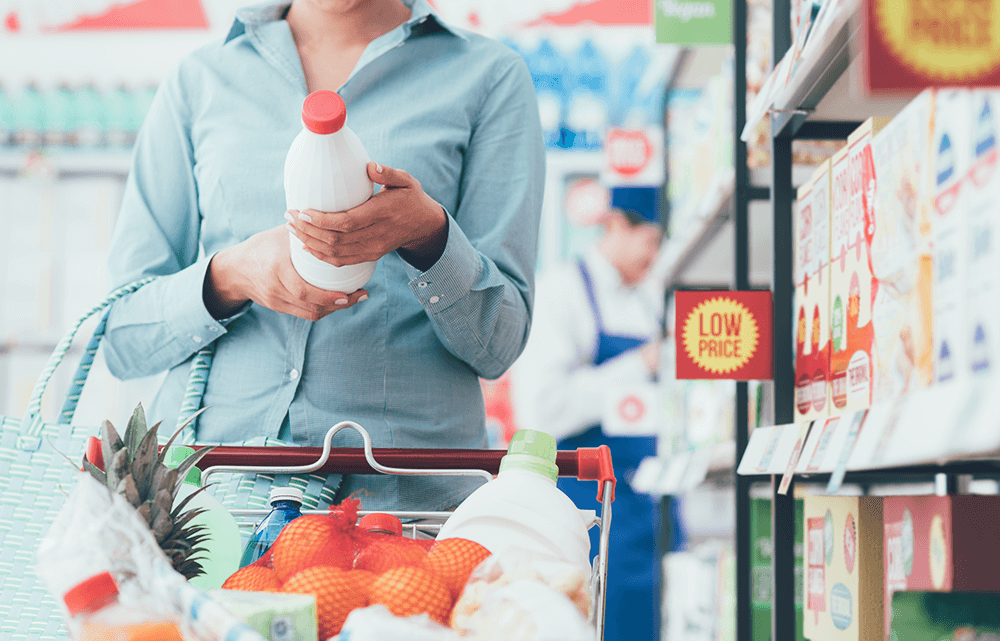 Front of package nutrition labels gain global momentum.
Front of package nutrition labels gain global momentum.Front of pack nutrition labeling (FOPNL) has been put forward by public health experts as a solution to the growing global issues of obesity and chronic diseases. Over the years, FOPNL has evolved from simply highlighting nutrient-specific information from the label on the back of the package to newer labeling that uses color-coding and symbols that rank the healthfulness of foods. It has the potential to guide consumer behavior on food choices while increasing transparency of food systems. FOPNL is gaining momentum on the global stage as governments in Europe and around the world, as well as the World Health Organization, work to create standards and unification.11 Global leaders aim to create uniformity in future label systems to prevent trade barriers, reduce confusion and encourage country-level adoption. 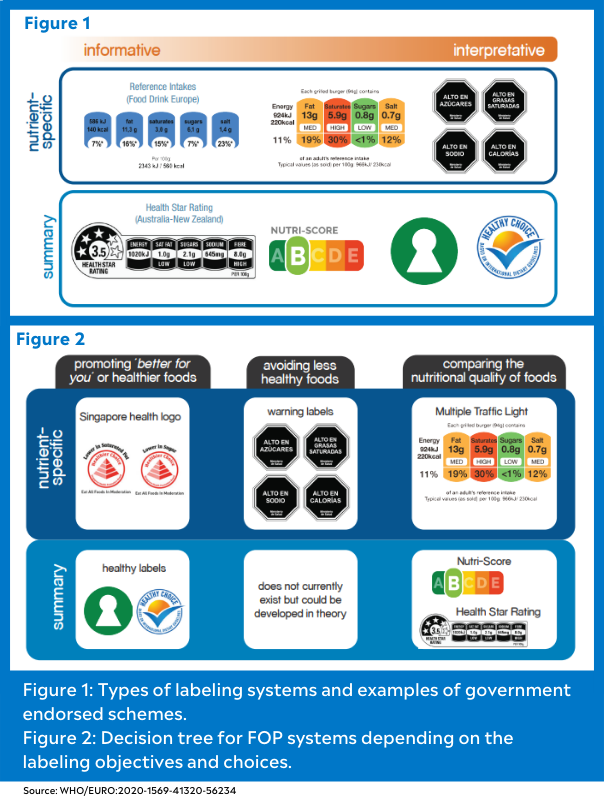
Organizations that have been working with food companies to develop FOPNL for various products are beginning to shift their focus from working with the food industry to working with governments to improve public health. The Choices International Foundation’s “healthy choice” logo is one example of an initiative that is making this shift.12 Plans for the “healthy choice” logo system include ranking foods based on healthfulness and working with governments to implement policies, based on rankings, for situations such as food marketing to children. Improving nutrition is not the only outcome of FOPNL efforts, as sustainability is also gaining ground in the label space, with several eco-labels already being tested and used in different countries. Foundation Earth is an organization working with the United Kingdom government and several food companies to create an FOPNL that provides environmental scores for foods based on four criteria: water usage, water pollution, biodiversity and carbon.13
For now, the United States is falling behind on the FOPNL front, but that may not be for long. The FDA is working on updating the definition of its “healthy” claim, which may include a proposal for a front of package symbol. The Food Labeling Modernization Act of 2021 was recently introduced to Congress and aims to update food labeling laws, including requiring a standardized front of package nutrition symbol.14 These efforts demonstrate the momentum FOPNL is gaining in U.S. policy.
Implication: FOPNL has the potential to influence consumer food purchasing decisions, change how companies formulate foods and impact nutrition policy and education. FOPNL may also help consumers better identify specific nutrients, or combinations of nutrients, within food groups or categories that may be especially important for optimal nutrition during key life stages, such as childhood, pregnancy or older adulthood. As FOPNL policies are still being tested and driven, the food industry and other groups are in a position to provide input and prepare. Dairy Council of CA will continue to support the dairy community to inform and educate on dairy’s unique nutrient contributions to a healthy, sustainable diet.

 Shift to Nutrition Security
Shift to Nutrition SecurityAs issues like malnutrition, food insecurity and sustainable food systems continue to take hold of global agendas, a shift in focus from food security to nutrition security has become a call to action. Nutrition security focuses not just on access and availability but on nutritious foods that support optimal health and prevent disease while embracing cultural preferences. Achieving nutrition security centers on diet quality rather than sufficient calories.
 The COVID-19 pandemic heightened the awareness of the long-term issues of hunger and food insecurity that families face
in many communities. At the same time, some health outcomes have worsened, including a significant increase in childhood obesity and rates of depression and anxiety.15,16 This led to increased funding streams and interventions that have been fast-tracked for implementation. As the nation begins to emerge from the pandemic, there is momentum to continue these investments that uplift
communities with a focus on equity. Universal free school meals, implemented nationwide during the pandemic, became permanent by law in California, the first state to do so; others are likely to follow. School breakfast and lunch programs provide
nutrient-rich foods and nutrition security for many children, especially in underserved communities. With free meals available to all students, schools anticipate increased participation, reduced stigma and overall improved nutrition, health and academic
success. The USDA recently modernized the Thrifty Food Plan, which is used to calculate Supplemental Nutrition Assistance Program (SNAP) benefits.17 This led to an increase in benefits,
improving a family’s ability to make healthy food purchases. Food banks experienced increased budgets from donor support during the pandemic, and these investments will likely continue as more donors are aware of the need for nutritious foods.
Food banks are looking to increase the quality of food available by placing more emphasis on purchasing food over relying on donated foods.
The COVID-19 pandemic heightened the awareness of the long-term issues of hunger and food insecurity that families face
in many communities. At the same time, some health outcomes have worsened, including a significant increase in childhood obesity and rates of depression and anxiety.15,16 This led to increased funding streams and interventions that have been fast-tracked for implementation. As the nation begins to emerge from the pandemic, there is momentum to continue these investments that uplift
communities with a focus on equity. Universal free school meals, implemented nationwide during the pandemic, became permanent by law in California, the first state to do so; others are likely to follow. School breakfast and lunch programs provide
nutrient-rich foods and nutrition security for many children, especially in underserved communities. With free meals available to all students, schools anticipate increased participation, reduced stigma and overall improved nutrition, health and academic
success. The USDA recently modernized the Thrifty Food Plan, which is used to calculate Supplemental Nutrition Assistance Program (SNAP) benefits.17 This led to an increase in benefits,
improving a family’s ability to make healthy food purchases. Food banks experienced increased budgets from donor support during the pandemic, and these investments will likely continue as more donors are aware of the need for nutritious foods.
Food banks are looking to increase the quality of food available by placing more emphasis on purchasing food over relying on donated foods.
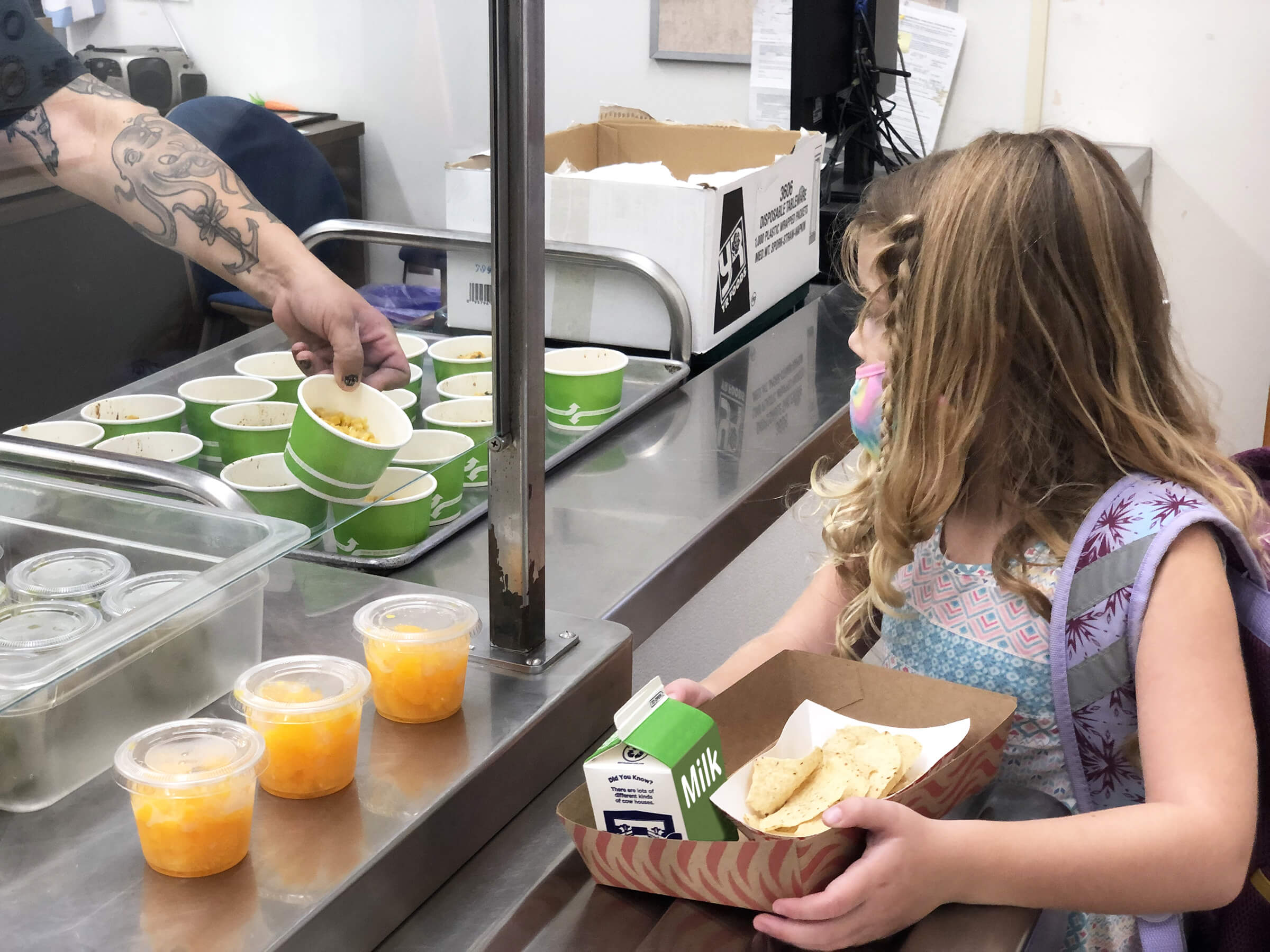 Solutions centered on nutrition security are happening on a global level as well. The United Nations held its Food Systems Summit, aimed at prioritizing actions across sectors to achieve a resilient, healthy global food system.18 The United States joined Nutrition, Health and Education for Every Child, the global school meals coalition that was launched in conjunction with the Food Systems Summit and supports comprehensive and effective school feeding programs worldwide by advocating for multisector coordination, stable funding sources and ongoing research to improve program quality and efficiency.19 The goal of the coalition is to help ensure that every child around the world has access to nutritious school meals by 2030.
Solutions centered on nutrition security are happening on a global level as well. The United Nations held its Food Systems Summit, aimed at prioritizing actions across sectors to achieve a resilient, healthy global food system.18 The United States joined Nutrition, Health and Education for Every Child, the global school meals coalition that was launched in conjunction with the Food Systems Summit and supports comprehensive and effective school feeding programs worldwide by advocating for multisector coordination, stable funding sources and ongoing research to improve program quality and efficiency.19 The goal of the coalition is to help ensure that every child around the world has access to nutritious school meals by 2030.
Implications: Expanding children’s and families’ ability to access nutrient-dense foods through federal nutrition assistance programs such as school meals and SNAP helps position milk and dairy foods as a solution to achieve nutrition security—not just food security. Especially important during childhood, nutrition and access to high-quality foods like milk and dairy foods can positively impact lifelong health. Dairy Council of CA continues to support food access programs and nutrition education initiatives that benefit communities across the state.

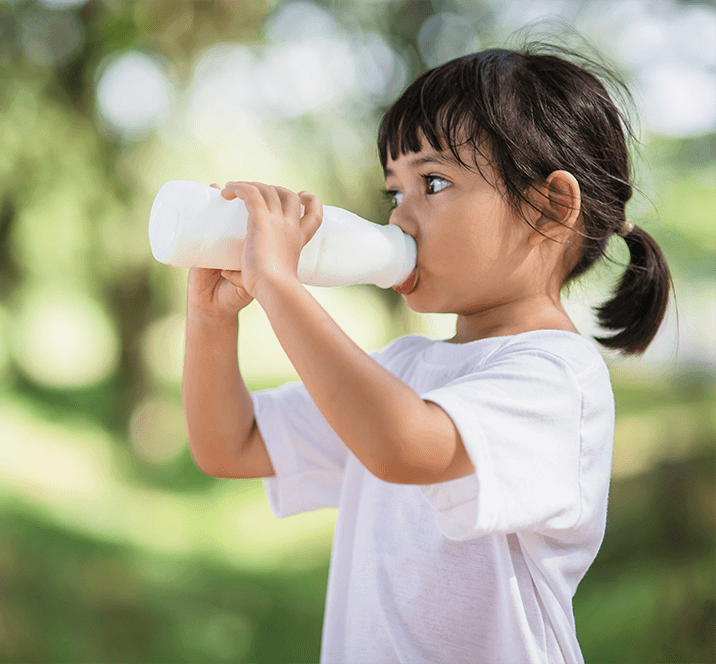 The Gut Microbiome and the Future of Health and Dietary Recommendations
The Gut Microbiome and the Future of Health and Dietary Recommendations The gut microbiome has emerged as a key influence on human health. Research continues to discover how microbes in the gut—mainly bacteria—provide beneficial functions, or dysfunction, within the body. These microbes exist in a symbiotic relationship with the rest of the body and are impacted by factors such as the food we eat to impact health and disease risk, including inflammation and immunity. Disruption to the relationship between the microbiome and human host, such as a decrease in the diversity or activity of microbes in the gut, has consistently been found as a common thread in chronic diseases.20 Beyond disease risk, new research is exploring the way the gut microbiome impacts bone health, suggesting it may work to help regulate the bone material itself by weakening or strengthening it depending on the microbes involved in altering the bone matrix.21 This is an example of how nutrition science is beginning to understand the health impacts of foods beyond isolated nutrients. The gut microbiome is complex, and its composition and function are highly individualized to each person. More research is still needed to help understand how specific foods and combinations of food interact with the gut microbiome.
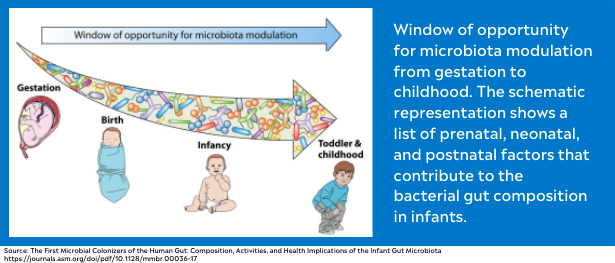 An individual’s gut microbiome is established during the first
two years of life. Nutrition has a significant influence on the development of the microbiome early on, which could have long-lasting health effects. Healthy growth and development for infants is linked to healthy microbiome development; undernutrition
occurring during this stage could have lasting impacts on microbiome function and overall health.22 This insight could have broad implications for child nutrition and preventative health.
Future dietary guidance may need to consider not only how foods meet nutritional requirements for humans but also how they affect the microbes living in the gut.
An individual’s gut microbiome is established during the first
two years of life. Nutrition has a significant influence on the development of the microbiome early on, which could have long-lasting health effects. Healthy growth and development for infants is linked to healthy microbiome development; undernutrition
occurring during this stage could have lasting impacts on microbiome function and overall health.22 This insight could have broad implications for child nutrition and preventative health.
Future dietary guidance may need to consider not only how foods meet nutritional requirements for humans but also how they affect the microbes living in the gut.
 Implications: Dairy foods continue to have a strong evidence base supporting their role in a healthy microbiome. Key to this research is the understanding of different dairy foods’ unique matrices that show health benefits beyond traditional nutrients.
Investments in dairy nutrition science are starting to uncover the functional benefits of dairy, such as how it interacts with the gut microbiome to impact mood, immunity and inflammation. Dairy Council of CA continues to monitor and track new research
on dairy’s functional benefits to inform the dairy community and to amplify discoveries to health professionals.
Implications: Dairy foods continue to have a strong evidence base supporting their role in a healthy microbiome. Key to this research is the understanding of different dairy foods’ unique matrices that show health benefits beyond traditional nutrients.
Investments in dairy nutrition science are starting to uncover the functional benefits of dairy, such as how it interacts with the gut microbiome to impact mood, immunity and inflammation. Dairy Council of CA continues to monitor and track new research
on dairy’s functional benefits to inform the dairy community and to amplify discoveries to health professionals.

1. Sloan AE. Demographic disruption. Food Technology Magazine. Institute of Food Technologists website. https://www.ift.org/news-and-publications/food-technology-magazine/issues/2021/july/features/demographic-disruption. Published July 1, 2021. Accessed October 4, 2021.
2. Reset the Table: Transforming the US Food System – Messaging Guide and Research Findings. The Rockefeller Foundation; 2021. https://www.rockefellerfoundation.org/wp-content/uploads/2021/04/Food-System-Transformation-Messaging-Guide_Feb-2021.pdf. Accessed October 4, 2021.
3. Reset yourself with dairy. Dairy Management Inc. US Dairy website. https://www.usdairy.com/reset-yourself-with-dairy. Accessed October 14, 2021.
4. Coach Terry’s touchdown! GoNoodle website. https://www.gonoodle.com/company/post/coach-terrys-touchdown. Accessed October 4, 2021.
5. Climate change ‘biggest threat modern humans have ever faced’, world-renowned naturalist tells Security Council, calls for greater global cooperation [press release]. United Nations; February 23, 2021. https://www.un.org/press/en/2021/sc14445.doc.htm. Accessed October 15, 2021.
6. Poinski M. Plant-based food worth $7B in 2020, posting 27% growth. Food Dive website. https://www.fooddive.com/trendline/plant-based foods/98/?utm_source=FDIng&utm_medium=BlastMay4&utm_campaign=Edlong. Published April 6, 2021. Accessed October 14, 2021.
7. California Farm to School Program. California Dept. of Food and Agriculture Office of Farm to Fork website. https://cafarmtofork.cdfa.ca.gov/CaFarmtoSchoolProgram.htm. Accessed October 15, 2021.
8. USDA awards $12 million in record-breaking Farm to School grants, releases new data showing expansion of Farm to School efforts [press release]. Washington DC: US Dept. of Agriculture Press; July 15, 2021. https://www.usda.gov/media/press-releases/2021/07/15/usda-awards-12-million-record-breaking-farm-school-grants-releases. Accessed October 4, 2021.
9. FY 2021 Farm to School grants awardees list. USDA Food and Nutrition Service website. https://www.fns.usda.gov/cfs/fy-2021-farm-school-grants-awardees-list. Published July 15, 2021. Accessed October 4, 2021.
10. FoodPrints curriculum lessons. FreshFarm Markets website. https://www.freshfarm.org/foodprints/curriculum/lessons. Accessed October 15, 2021.
11. Manual to Develop and Implement Front-of-pack Nutrition Labelling: Guidance for Countries on the Selection and Testing of Evidence-informed Front-of-pack Nutrition Labelling Systems in the WHO European Region. WHO Regional Office for Europe; 2020. https://apps.who.int/iris/handle/10665/336988. Accessed October 2, 2021.
12. Nutrition criteria. Choices International Foundation website. https://www.choicesprogramme.org/our-work/nutrition-criteria/. Accessed October 4, 2021.
13. Pilot launch. Foundation Earth website. https://www.foundation-earth.org/pilot-launch/. Accessed October 4, 2021.
14. H.R.4917 – Food Labeling Modernization Act of 2021. Congress.gov. https://www.congress.gov/bill/117th-congress/house-bill/4917. Accessed October 4, 2021.
15. Woolford SJ, Sidell M, Li X, et al. Changes in body mass index among children and adolescents during the COVID-19 pandemic. JAMA. 2021. DOI:10.1001/jama.2021.15036
16. Racine N, McArthur BA, Cooke JE, Eirich R, Zhu J, Madigan S. Global prevalence of depressive and anxiety symptoms in children and adolescents during COVID-19: a meta-analysis. JAMA Pediatr. 2021. DOI:10.1001/jamapediatrics.2021.2482
17. USDA modernizes the Thrifty Food Plan, updates SNAP benefits [press release]. Washington DC: USDA FNS Press Team; August 16, 2021. https://www.fns.usda.gov/news-item/usda-0179.21. Accessed October 4, 2021.
18. Food Systems Summit 2021. United Nations website. https://www.un.org/en/food-systems-summit/. Accessed October 4, 2021.
19. Led by USDA, US to join global school meals coalition [press release]. Washington DC: USDA Press; June 21, 2021. https://www.usda.gov/media/press-releases/2021/06/21/led-usda-us-join-global-school-meals-coalition. Accessed October 4, 2021.
20. Bassaganya-Riera J, Berry EM, Blaak EE, et al. Goals in nutrition science 2020-2025. Front Nutr. 2021;7. DOI:10.3389/fnut.2020.606378
21. Nutt D. Researchers look to gut microbiome to improve bone health. Cornell Chronicle. June 7, 2021. https://news.cornell.edu/stories/2021/06/researchers-look-gut-microbiome-improve-bone-health. Accessed October 4, 2021.
22. Chen RY, Mostafa I, Hibberd MC, et al. A microbiota-directed food intervention for undernourished children. N Engl J Med. 2021;384:1517-1528. DOI:10.1056/NEJMoa2023294